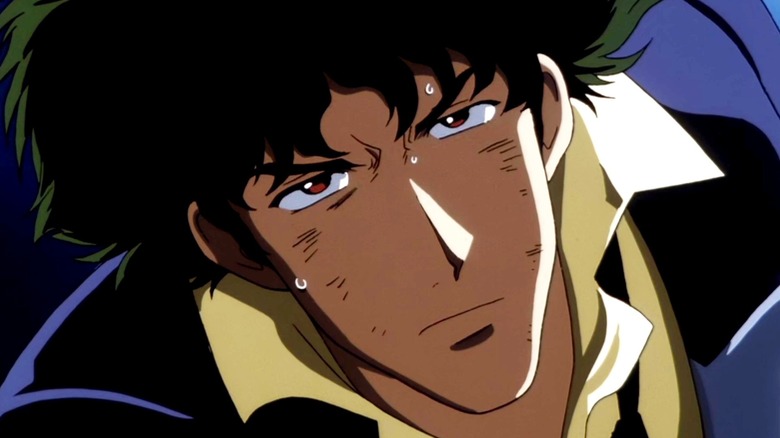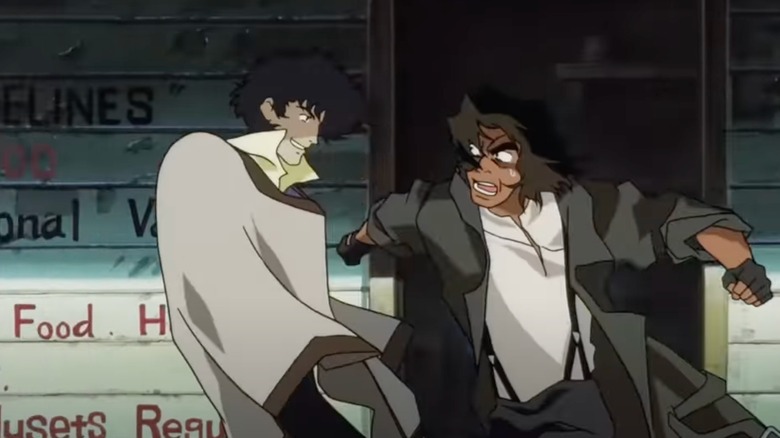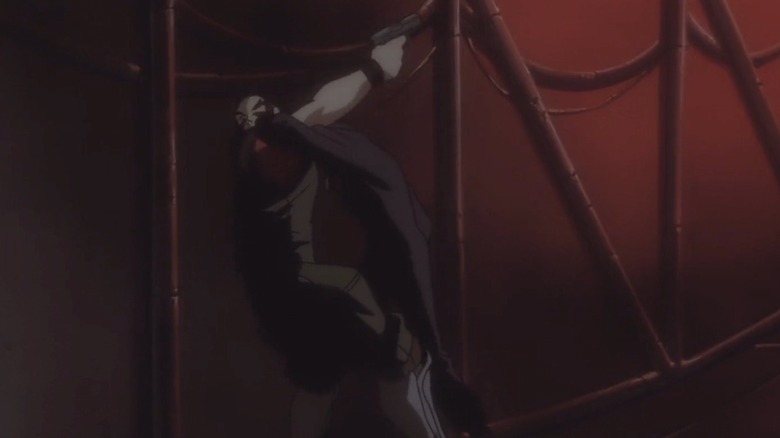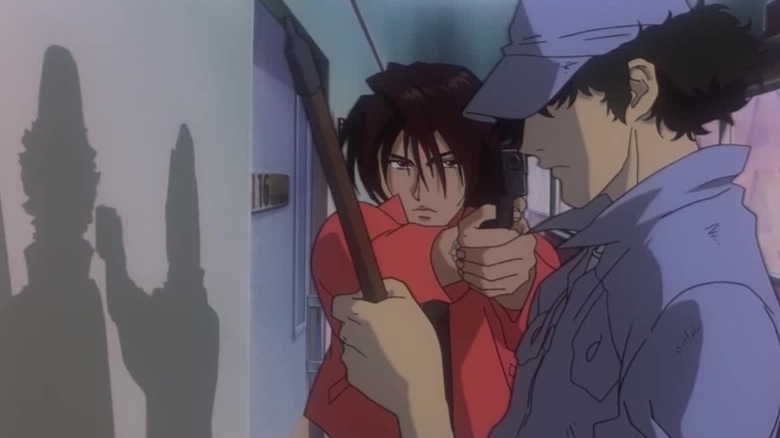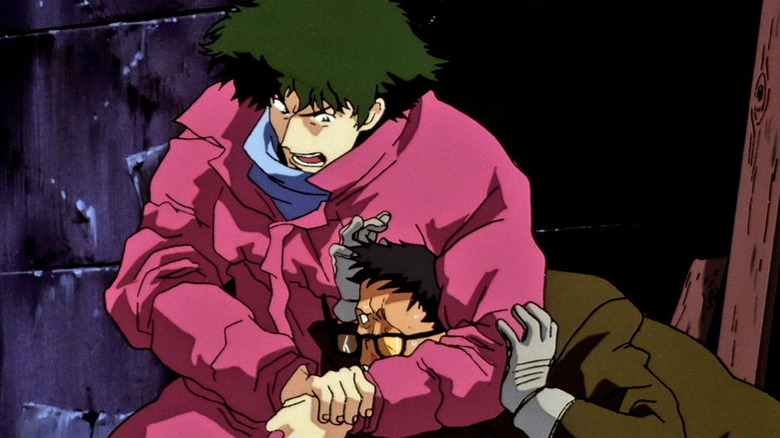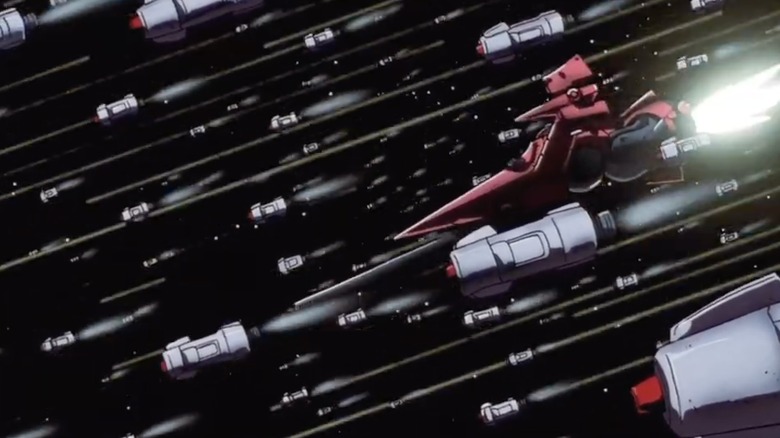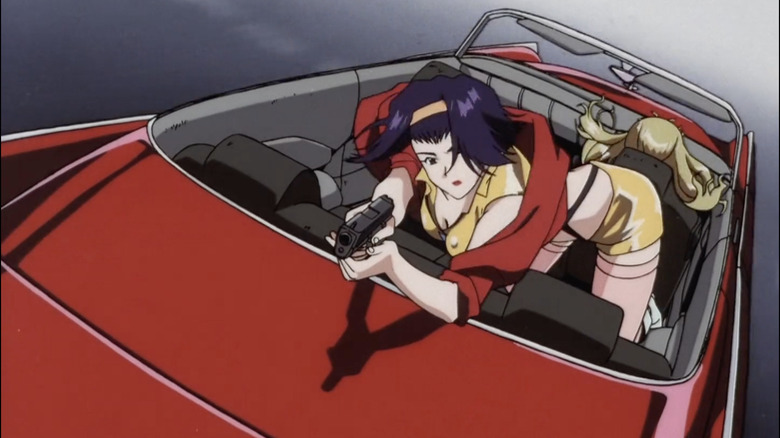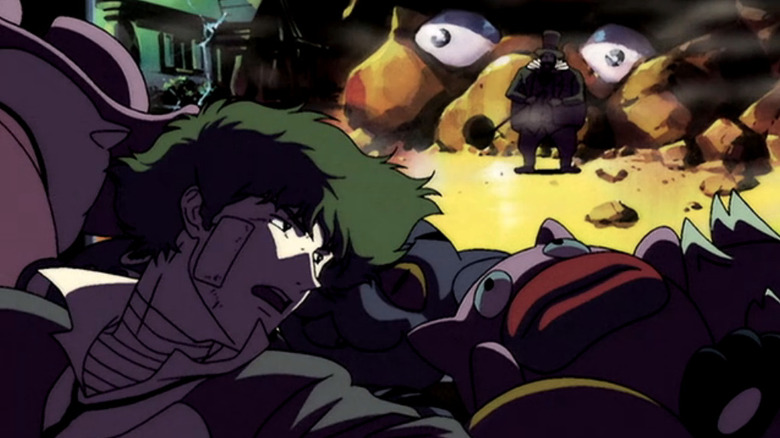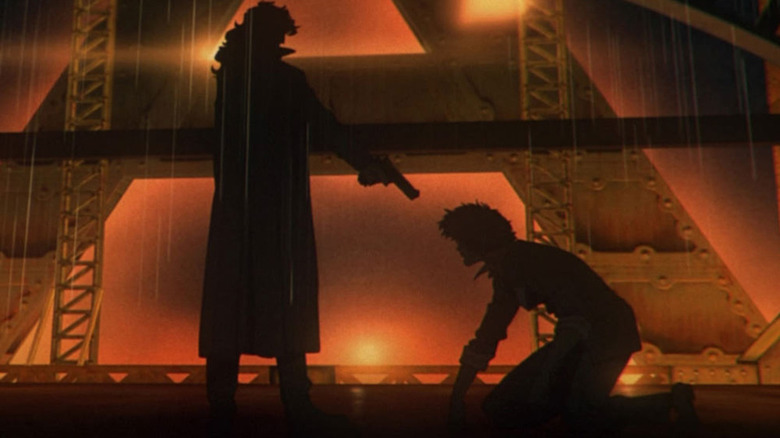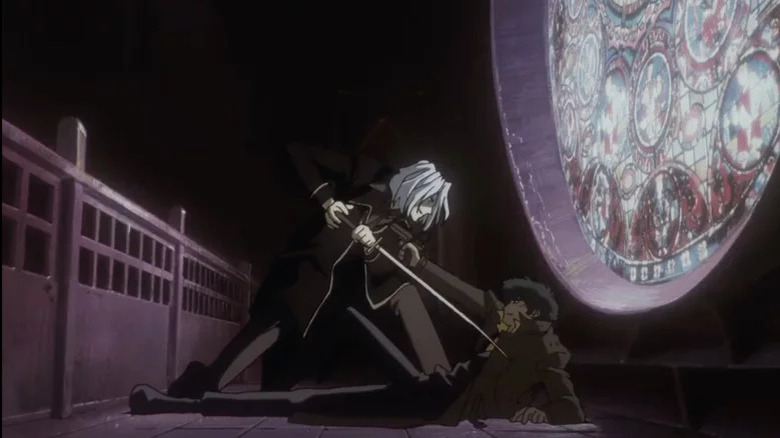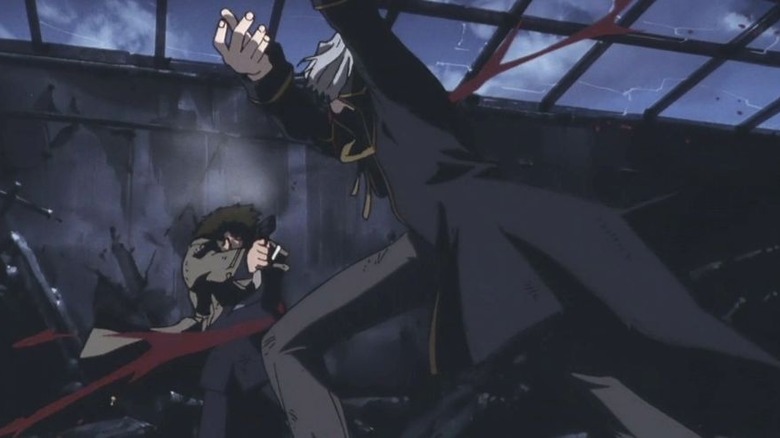The 10 Best Cowboy Bebop Fight Scenes Ranked
"Cowboy Bebop" is a masterpiece, lightning in a bottle, one of a kind, and every other superlative compliment you can throw its way. The series, produced by anime studio Sunrise as a spaceship toy cash grab and elevated by its creative team (from director Shinichirō Watanabe to composer Yoko Kanno), earns all the fond memories it has created.
The most talked about strengths of the series include Kanno's jazzy musical score, the heartbreaking loneliness of its characters, the impeccable title sequence "Tank!" and the way different episodes dance across different genres. ("Cowboy Bebop" is a title that evokes the series' vibe.) The many American "Cowboy Bebop" fans also fondly recall the show's English dub, which set a new bar for international anime dubbing.
The quiet moments of "Cowboy Bebop" are often the most effective. (The 2021 live-action version from Netflix failed to realize that dialogue is not the show's engine or beating heart.) Even so, there's undeniably plenty of great action, from fisticuffs to chase scenes to high-flying dogfights. Anti-hero Spike Spiegel has the martial philosophy and thin but muscular build of Bruce Lee, and the best action in "Cowboy Bebop" lives up to the shadow of "Enter The Dragon."
10. Spike vs. Asimov (Asteroid Blues)
The crew of the Bebop spaceship are bounty hunters. The frontier they hunt on, though, is the whole solar system — not the American West like cowboys of old.
Their first onscreen quarry in Session #1 "Asteroid Blues" is drug peddler Asimov Solensan. His product is "Bloody Eye," which when sprayed on the pupils turns the user into a super soldier with enhanced reaction time. Asimov demonstrates the product on himself to his first buyer. When some armed men come looking to steal his supply back, the scene cuts between shots of them firing and shots from Asimov's point of view. He's literally seeing red and the frame often shakes (representing his inhuman speed).
This introduction sets up that our heroes are in trouble if they cross him, but by the time he and Spike are trading blows the drug has loosened Asimov's grip. At an outdoor cafe, Spike poses as a Bloody Eye buyer (he's a trickster, after all) then drops the guise once he's gotten under Asimov's skin. An enraged Asimov lunges with his fists, while Spike dodges and favors the longer reach of his legs to hit back. The pair also use the tables around them as shields and acrobatic platforms, an understated way to make the environment key to the battle.
The character animation of "Cowboy Bebop," particularly the way characters' limbs stretch when punching or kicking, is one of the series' strengths. This battle, like Asimov showing off Bloody Eye, proves what the series can do.
9. Jet vs. Udai Taxim (Black Dog Serenade)
Film noir is one of the main ingredients in "Cowboy Bebop" and Session #16, "Black Dog Serenade," is one of the episodes that leans the most on the genre.
The Bebop's captain, Jet Black, was in his previous life a detective for the Inter-Solar System Police (ISSP). His old partner Fad enlists his help when a group of inmates hijack the prison ship they were on, "Con Air" style. Among the prisoners is the assassin Udai Taxim, the criminal who took Jet's left arm and nearly his life.
Jet is crankier than Spike, but he's also more cautious. He tries (and fails) to hold his partner back when he goes off looking for trouble. "Black Dog Serenade" gives Jet a brawl all his own. Taxim ambushes Jet in one of the ship's hallways; to amp up the atmosphere, episode director Ikurō Satō keeps the hallway underlit, the only light being an eerie blood red.
Taxim has the upper hand for most of the fight. He first corners Jet with his gun, then slams him against a wall, and even Jet blocks a shot with his metal arm then hits back with a headbutt, Taxim throws a knife up his sleeve into Jet's leg. His worst hit is a psychological one: Fad was on the Syndicate's take and it was him who shot Jet. Cue Fad entering and blowing Taxim's brains out, getting himself ultimately killed out of guilt for betraying Jet. (The scene foreshadows this; cutting between the shell casings dropping from Taxim's guns to Fad emptying all but one of the bullets from his revolver.)
8. Spike vs. Elektra (Knockin' On Heaven's Door)
Like many popular anime series, "Cowboy Bebop: The Movie" got a feature-length spin-off, released in 2001 a couple years after the show wrapped. "Cowboy Bebop" fans wanting answers after the ambiguous ending shouldn't look here. The movie, "Knockin' On Heaven's Door," is set-in between episodes and basically just a two-hour long Session.
With a higher budget than the series — and Sunrise getting help from nascent anime studio Bones, formed by ex-Sunrise animators — the movie's animation is a tad cleaner and higher definition than the series. The action is just as good too.
Spike, posing as a janitor, infiltrates the headquarters of pharma giant Cherious, which is trying to hush up its connections to a terrorist attack on Mars. Soon, he's sparring with Cherious security officer Elektra Ovilo. Elektra proves she can equal Spike's acrobatic fighting, but she's all business and has no interest in matching wits with him.
Despite her efforts, Elektra doesn't quite manage to do that. Spike uses his broom as a makeshift bo staff, keeping Elektra out a distance and even knocking her gun away by standing on the broom's end and sending the stick part flying into Elektra's face.
7. Spike vs. Callisto Goons (Jupiter Jazz)
The "Cowboy Bebop" series midpoint — two-parter "Jupiter Jazz" — is set on the moon Callisto. It may have breathable air but it's still a frozen wasteland, terraforming or no. Spike, asking around for info about his missing lover Julia, finds himself cornered in an alley by some local thugs.
When they mistake him for his rival Vicious, Spike's usual calm breaks (he punches a huge dent in a nearby pipe without breaking any sweat or bones). Declaring, "You don't know what Vicious is!" Spike literally jumps into battle, slamming one in the face with a kick and becoming a human hurricane of punches and kicks as he takes out the crowd of a dozen or so. His movements are as graceful as ever but this is Spike's angriest fight. The sound design complements the brutality with crunching sounds of bodies slamming into walls and breaking wooden boxes on impact.
Unfortunately, we're robbed of seeing these thugs get another beatdown when they corner Faye Valentine, the Bebop's own butt-whooping femme fatale, later in the episode. She gets only one marvelous roundhouse kick in before the chivalrous Mr. Gren grabs her hand and leads her away.
6. The hyperspace missile chase (Gateway Shuffle)
"Cowboy Bebop" isn't quite a space opera — despite the setting, its conflicts are too personal. While our leads are small fry, they also each have a one-man spaceship and the show has plenty of great space-set fights.
In Session #4, "Gateway Shuffle," a group of eco-terrorists are planning to bomb the moon of Ganymede with a virus that genetically regresses humans into simians. As the missiles carrying the virus-payload sprint through hyperspace, Spike leaps into his Swordfish II and flies out to shoot it down. The sequence is a perfect example of "Bebop" mixing sci-fi and jazz together into a harmony. The score of a spaceship charging through space isn't a sweeping orchestra like John Williams' work on "Star Wars," but a high-strung foot-tapping beat.
The chase is a race against time that still finds room for humor; when the missile splits into three and one makes it past Spike, Faye offers to shoot it down in her Red Tail for 80% of the bounty. Cue some extremely fast-paced negotiation where Spike and Jet work her down to 60/40, and Faye counters that she'll get the 60% of that. Once Faye gets into hyperspace, the missile turns into a mini-bomb spread that'll be impossible to stop. Both she and Spike have to rush to the hyperspace gate before the authorities shut it off, and they make it with only a second to spare.
Even outside fist-to-fist fights and with no opponent for our heroes besides a ticking clock, "Cowboy Bebop" always delivers thrilling action.
5. Faye and Julia vs. Syndicate Goons (The Real Folk Blues)
It's not just spaceship action where "Cowboy Bebop" excels — the show can nail a good old-fashioned car chase too. It speaks to the show's unique setting/genre blending that both spaceships and cars are right at home in it.
Spike spends the whole of "Cowboy Bebop" longing for Julia but she only shows up in present day during two-part series finale "The Real Folk Blues." In part one, the women of Spike's past and present meet up. Faye (and the audience) learn that Spike really does love women who can best him.
The scene: Faye is fueling up Red Tail at an airport when Julia comes speeding by in her convertible, pursued by Syndicate men following her in their own cars. Faye, for once choosing to play the good Samaritan, leaps into action and shoots out the tire on one of the pursuing cars. Julia does a u-turn and lets Faye in. Then, while leaning out over the rear of the car, Faye again shoots out the tire on the second car and sends it tumbling into a fireball.
Many of Faye's action scenes across the series are false starts or quickly-ended (she is a screwup in more ways than one). Before the series closes, though, she gets her chance at being a hero.
4. Spike vs. Mad Pierrot (Pierrot Le Fou)
I said at the start that this anime goes through every genre it can. "Cowboy Bebop" Session #20 "Pierrot Le Fou" is titled after Jean-Luc Godard's French New Wave romance film, but the title is all they have in common. This episode is where "Bebop" ventures into horror: Spike's latest enemy, Mad Pierrot, is a smiling, flying madman. Jet and the Bebop's child hacker Ed discover that Pierrot was the product of a "failed" super-soldier experiment, but that's not relevant to Spike. What is is that he's finally met someone he can't beat.
Spike and Pierrot face off twice. The first time, Spike is wandering out of a bar and is unlucky enough to stumble across Pierrot having just killed someone else. The second time, Pierrot lures Spike to the freakiest theme park since Pleasure Island in "Pinocchio."
The first fight opens with the pair exchanging some bullets, but Pierrot emits an energy shield that blocks Spike's shots. Spike's quick punches are also useless against someone who can float with the weightlessness of a balloon, and he gets whooped. The second fight is even worse, as Pierrot hunts Spike through the theme park like a slasher villain chasing his prey. "Pierrot Le Fou" even uses horror movie-style lighting, with heavily shadowed backgrounds but excess lighting on Spike himself. This amps up the contrast and the scariness.
3. Spike vs. Vincent (Knockin' On Heaven's Door)
The villain of "Knockin' On Heaven's Door" is Vincent Volaju, a former soldier (and Elektra's lover) who was driven insane in a medical experiment. Convinced the whole world is a dream, he's planning to kill everyone on Mars with the nanomachines that drove him mad, thinking that only this can wake him up from Purgatory.
Vincent's solipsism and his past with Elektra is a dark mirror of Spike's fatalism and his romance with Julia; of course the two men come into conflict. Their final fight, set against an orange-drenched sunset background, is so hard-hitting you'd swear it was two real men putting flesh to flesh. Spike gets more clean hits overall, but Vincent's strength prevails. He's won the fight from the moment it starts and Spike's "flow like water" fighting style is, this time, doing as little damage as waves crashing against rocks.
The relentless flurry of punches and kicks is the type of fight you'd see in plenty of "Bebop" episodes, but the feature film scope allows for a longer and more detailed fight. "Knockin' On Heaven's Door" is playing the same beat as the fights in the series but at a higher tempo.
The fight comes to a sad end when Elektra shoots Vincent (she wanted them to die together, but he refuses to shoot her). As he lays dying, he tells her: "Of the days that I have lived, only those I spent with you seemed real." Spike looks on like he's just seen his past reflected right back at him.
2. Spike vs. Vicious, Round One (Ballad of Fallen Angels)
Watanabe considered "Cowboy Bebop" Session #5 "Ballad of Fallen Angels" to be the series' make-or-break moment. It was definitely a "make it" episode; the only thing that gets broken in this episode are Spike's bones.
"Ballad of Fallen Angels" is Vicious's debut and the first episode to allude to Spike's past with the Syndicate. Vicious kidnaps Faye and demands Spike meet him in an abandoned church on Mars. Naturally, Vicious doesn't play fair and brings a small army — one that Spike manages to take out near single-handedly. The layout of the church again factors into the fight. Vicious' men hide behind pews while Spike ducks in and out from pillars. The main source of light in the scene also comes from the stained glass windows. Spike gunfighting some henchmen is fun enough, but the scene becomes downright transcendent once he and Vicious are squaring off.
Spike, panting and with a gut wound, stands still with his back to some darkness. Vicious sneaks up behind him, his outline barely piercing the darkness, and begins slashing with his sword. Spike falls to the ground. Cue two lighting fast close-ups of Spike reaching for his gun and Vicious stabbing his blade, then a wide shot of them now locked in the most up-close Mexican stand-off ever.
After exchanging some cutting words, they both go for the killing stroke (or shot, in Spike's case). After that, a wounded Vicious then throws Spike out the window behind them. The scene ceases being a fight. Spike falls in slow motion as the melancholic "Green Bird" plays and he recalls his past with Julia. Before he hits the ground, your jaw is already there.
1. Spike vs. Vicious and the Syndicate (The Real Folk Blues)
The very first "Cowboy Bebop" scene ever (opening "Asteroid Blues") is from Spike's past. After being stood up by Julia, he walked into an ambush led by Vicious and barely came out. The series suggests that Spike hasn't really been alive since that moment, but just an empty man drifting through life. So, his last act in "Real Folk Blues" (after losing Julia again and forever) returns to the way the audience first met him: he storms the Syndicate headquarters to confront Vicious.
Spike opens the battle with some grenades, creating an explosive start to the end. From there, the fight is basically an extended version of the "Ballad of Fallen Angels" climax — Spike dodging bullets and firing many in return. The score ("See you, Space Cowboy," an instrumental remix of the series' closing theme "The Real Folk Blues" but with new lyrics) plays as Spike climbs the tower floor by floor, bleeding all the way but making other men bleed even more.
Once he reaches Vicious, the music stops. Spike may be wielding a gun, but their last fight is basically a sword duel. When Vicious whips out his blade, Spike uses his gun to block it (while firing off a few rounds). In the last moment, they both drop their weapons, pause for a moment, then kill each other (but only Spike's shot to Vicious' heart is instantly lethal). It's an ending right out of the scene in many Westerns where two gunslingers stand mere paces away from each other, trying to guess whether they or their opponent can grab their gun and make a shot before they can. Spike took his last life just like a cowboy would.
